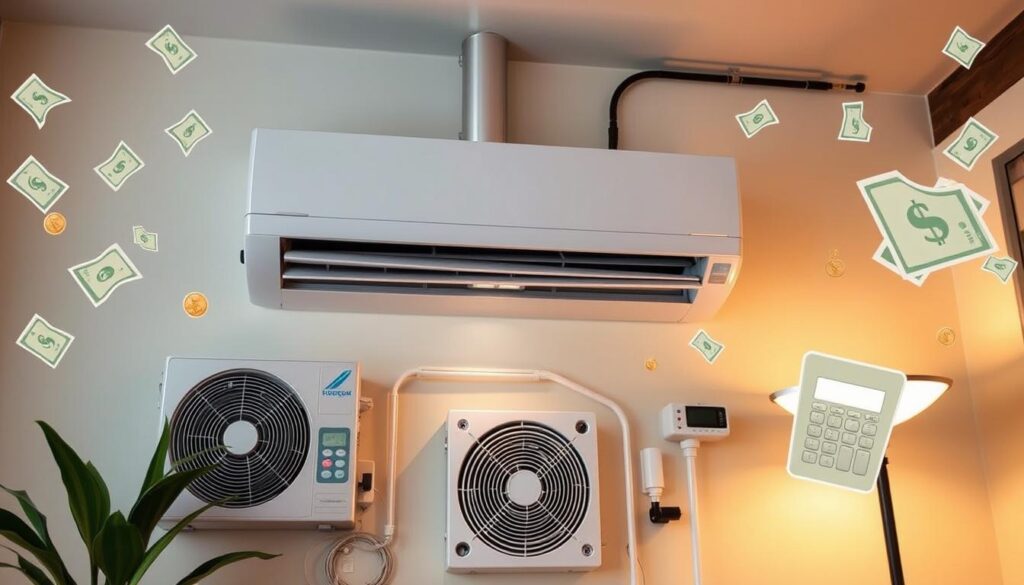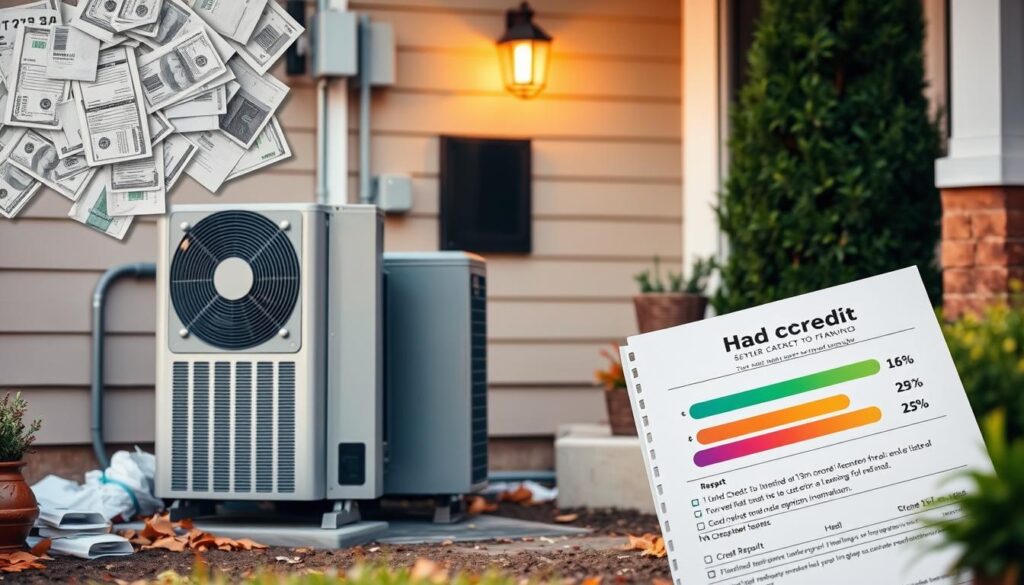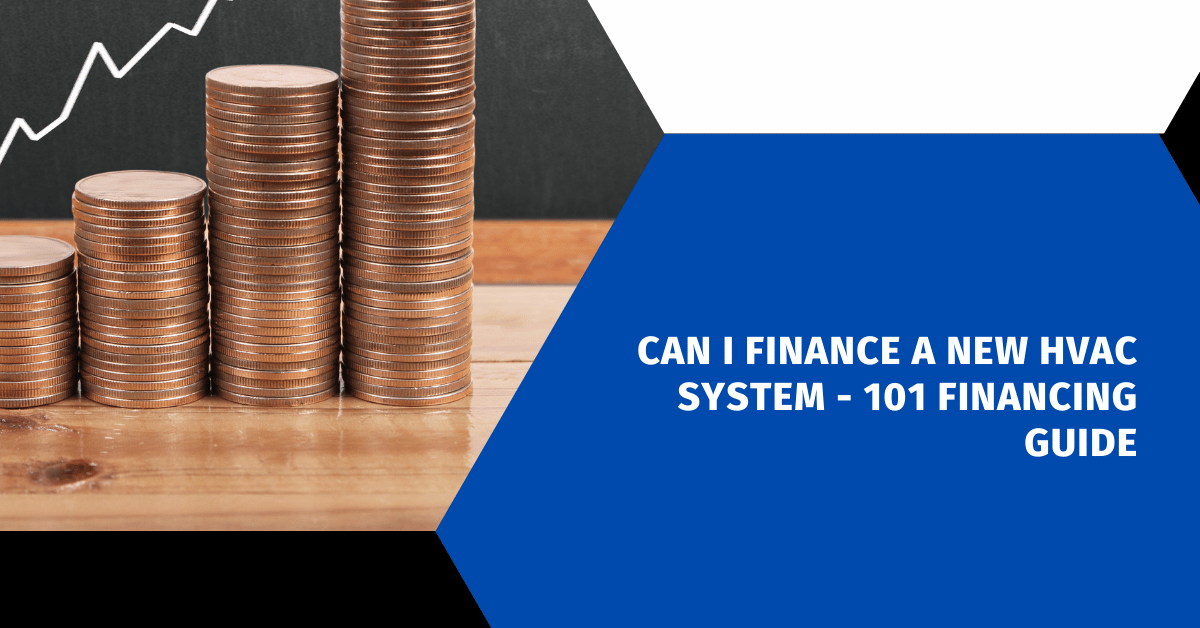Affiliate Disclosure
HVAC Guide Guys is a participant in the Amazon Services LLC Associates Program, an affiliate advertising program designed to provide a means for sites to earn advertising fees by advertising and linking to Amazon.
Can I Finance a New HVAC System? Getting a new HVAC system can cost a lot, from $3,000 to $10,000 or more. Most homeowners can’t pay for it all upfront. Luckily, there are ways to finance this important upgrade. But, the big question is – can you finance a new HVAC system?
In this guide, we’ll look at financing options for a new HVAC system. We’ll also talk about what affects the cost and how to choose the right option for your home and budget. Whether your credit is great or not so good, there are ways to get the cooling and heating your home needs.

Key Takeaways
- HVAC system replacement can cost anywhere from $3,000 to $10,000, including installation.
- Financing options include personal loans, home equity loans, credit cards, and manufacturer financing.
- Credit score requirements and income levels vary among lenders for HVAC financing.
- Federal tax credits and rebates can significantly reduce the final cost of a new HVAC system.
- Carefully compare financing options to find the best fit for your budget and long-term financial goals.
Table of Contents
Understanding HVAC System Costs and Financing Needs
Getting a new HVAC system is a big step for your home. It’s important to think about the costs and how to pay for it. The HVAC system cost can range from $3,000 to $10,000 for a full install.
Factors Affecting HVAC System Pricing
Many things can change the HVAC system pricing. The size of your home and the type of equipment matter a lot. Also, how easy or hard it is to install can affect the financing needs.
The state of your ductwork and if you need to change it can also raise the installation expenses.
Average Cost Ranges for New Systems
- Central air conditioning system: $3,000 – $7,000
- Heat pump system: $4,000 – $8,000
- Furnace and air conditioner combo: $4,500 – $9,500
- Ductless mini-split system: $2,000 – $14,000 (depending on the number of indoor units)
Installation and Additional Expenses
Costs for installing the system are also important. They can be from $1,000 to $4,000 or more. This includes ductwork changes, electrical work, and getting rid of the old system.
| HVAC System Type | Average Total Cost (Equipment + Installation) |
|---|---|
| Central Air Conditioning | $4,000 – $11,000 |
| Heat Pump | $5,000 – $12,000 |
| Furnace and Air Conditioner | $5,500 – $13,500 |
| Ductless Mini-Split | $3,000 – $18,000 |
It’s key to know the HVAC system cost, financing needs, and installation expenses before getting a new system. Talking to a local HVAC contractor can help you make a smart choice for your home and budget.
Explore Our HVAC Shop
Looking for top-rated HVAC tools, parts, and accessories? Visit our shop and find the perfect solution for your needs.
Visit the ShopKey Considerations Before Financing Your HVAC System
Financing your new HVAC system involves several key factors. Your home tenure, interest rates, and down payment requirements are crucial. They can affect the cost and long-term financial impact of your investment.
Your credit score is a major consideration. It influences your loan approval and interest rates. Even with a lower credit score, you might still find financing options. However, the terms might not be as good. It’s important to compare different financing options to find the best one for you.
Understanding the total cost of the HVAC system is also essential. This includes the equipment, labor, and any disposal fees. Knowing this information helps you make a well-informed decision and avoid unexpected expenses.
Before agreeing to any financing, read the fine print carefully. Look at the interest rates, loan duration, and monthly payments. This ensures the long-term financial impact fits your budget and goals.
“Financing an HVAC system requires careful consideration of your financial situation, credit profile, and the total cost of the investment. By evaluating these factors, you can make an informed decision that best suits your needs.”
By researching your HVAC financing considerations, understanding your credit score, and comparing loan terms, you can make a confident choice. This choice will benefit you and your home for years.
Available HVAC Financing Options
Replacing or upgrading your HVAC system can be expensive. But, there are many financing options to help. Let’s look at some common ones:
Personal Loans
Personal loans from banks or credit unions are a good choice. They might have higher interest rates but don’t need collateral. You can choose a term from 36 to 60 months, giving you flexibility.
Home Equity Loans
Home equity loans or HELOCs are great if you’ve built up home equity. They use your home as collateral, which can lower interest rates. But, you risk losing your home if you can’t pay back the loan.
Credit Cards
Credit cards offer quick financing for HVAC systems but have high interest rates. Some HVAC companies offer special financing through credit cards. This can include 0% interest for a short time, which is helpful.
Manufacturer Financing
Many HVAC manufacturers, like Trane, work with lenders for special financing. These deals might have low or zero-interest periods. They’re a good option for upgrading your system.
When looking at financing options, compare interest rates, terms, and fees. By exploring these choices, you can find the best fit for your budget and goals.
Explore Our HVAC Shop
Looking for top-rated HVAC tools, parts, and accessories? Visit our shop and find the perfect solution for your needs.
Visit the ShopCan I Finance a New HVAC System with Bad Credit?
Financing a new HVAC system is possible, even with bad credit. There are many options to help you get the heating and cooling system your home needs. This is true, no matter your credit history.
Bad credit HVAC financing and low credit score options are more accessible than you might think. Many HVAC companies offer special financing programs for customers with lower credit scores. These plans often don’t require a down payment and have flexible payment terms to fit your budget.
You can also look into personal loans from alternative lenders or secured credit cards. Home equity loans are another option if you have a lot of equity in your home.
According to data, 45.2% of Americans have fair to poor credit, and 54% live paycheck-to-paycheck. Luckily, options like PACE financing, Home Run Financing, and lease agreements can help. They offer immediate solutions for homeowners with bad credit or limited financial resources.
| Financing Option | Credit Requirements | Potential Benefits |
|---|---|---|
| PACE Financing | No credit checks required | Immediate solution for homeowners, finance a wide range of HVAC upgrades |
| Home Run Financing | No credit score requirements | Finance energy-efficient furnaces, boilers, and biomass heating systems |
| HVAC Leases | Flexible credit requirements | Low monthly payments, early payoff options, and potential energy savings |
Whether you have bad credit or a limited budget, there are financing solutions for you. These options can help you upgrade your HVAC system and make your home more comfortable. By exploring these options, you can find a financing plan that meets your needs and financial situation.

“PACE financing allows homeowners to finance a wide range of heating or cooling solutions for their homes, offering an immediate solution with no credit requirements.”
Understanding Interest Rates and Payment Terms
When you finance a new HVAC system, interest rates and payment terms matter a lot. The rates can be fixed or variable. Each has its own benefits based on your financial situation.
Fixed vs. Variable Rates
Fixed-rate financing means your monthly payments stay the same. This makes budgeting easier. But, variable rates can change, leading to higher or lower payments. If rates drop, you save, but if they rise, you might pay more.
Loan Duration Options
Loan terms for HVAC systems usually last from 2 to 7 years. Longer terms mean smaller monthly payments but more interest paid over time. Shorter terms require bigger payments but save you money in the long run.
Monthly Payment Calculations
Your monthly payments depend on the loan amount, interest rate, and term. For instance, a $10,000 loan at 0% APR for 60 months costs $167 monthly. But, higher rates or longer terms increase your monthly payments.
| Loan Amount | Interest Rate | Loan Duration | Monthly Payment | Total Interest Paid |
|---|---|---|---|---|
| $10,000 | 0% | 60 months | $167 | $0 |
| $10,000 | 5% | 60 months | $189 | $1,340 |
| $10,000 | 5% | 84 months | $144 | $2,088 |
Explore Our HVAC Shop
Looking for top-rated HVAC tools, parts, and accessories? Visit our shop and find the perfect solution for your needs.
Visit the ShopHVAC Company Financing Programs
Replacing your HVAC system can be expensive. But, many HVAC company financing programs help make it easier. These programs work with banks to offer special credit cards, loans, or lease options. This makes getting a new HVAC system simpler.
For example, Trane has a Wells Fargo Home Projects credit card. It has 0% APR for 60 months on equal payments. This helps spread out the cost. Carrier Authorized Dealers also offer flexible financing plans. These plans have good interest rates and payments that fit your budget.
If your credit score is lower or you’ve had financial issues, manufacturer financing programs like Microf’s can help. They offer lease-to-own options with flexible payments. You can choose from 36, 48, or 60 months, making it easier to afford a new HVAC system.
Many HVAC companies also use government incentives and rebates to help with costs. The U.S. government gives tax credits for installing central cooling systems with a SEER of 16 or higher. Some states and local governments, plus HVAC makers, offer rebates for energy-efficient systems.
When looking at HVAC company financing, compare rates, terms, and fees. This ensures you choose the best option for your money. Using these programs can help you upgrade your HVAC without spending too much.
| Financing Option | Key Features |
|---|---|
| Trane Wells Fargo Home Projects Credit Card | 0% APR for 60 months on equal payments |
| Carrier Authorized Dealer Financing | Flexible plans with competitive interest rates and manageable monthly payments |
| Microf Lease-to-Own Program | Flexible monthly renewal payments based on 36, 48, or 60 months |
| Federal Tax Credits for Energy-Efficient HVAC | Available for central cooling systems with a SEER of 16 or higher |

Federal Tax Credits and Rebates for HVAC Systems
Upgrading your HVAC system can be costly. But, there are federal tax credits and rebates to help. The Inflation Reduction Act of 2022 offers incentives for energy-efficient HVAC choices.
Available Tax Incentives
The tax credits for energy-efficient HVAC upgrades are available from 2023 to 2034. They range from $60 to $2,000, based on the system’s efficiency. Eligible systems include air-source heat pumps, central air conditioners, boilers, and furnaces with certain SEER2, EER2, HSPF2, and AFUE ratings.
Energy Efficiency Requirements
To get the tax credits, your system must meet energy efficiency standards. For instance, air-source heat pumps need a SEER2 rating of 16 or more. Central air conditioners must have a SEER2 of 14 or higher. Boilers and furnaces have specific AFUE ratings to qualify.
How to Claim Your Benefits
- Keep detailed records of your HVAC system purchase and installation, including manufacturer certifications.
- Complete IRS Form 5695 to claim the residential energy tax credits when filing your federal income taxes.
- Be aware of the annual $3,200 limit for stacking HVAC tax credits with other energy-saving home improvement credits.
- Consult with a tax professional to ensure you’re maximizing your HVAC-related tax benefits.
By using these HVAC tax credits and energy efficiency rebates, you can lower the cost of a new, energy-efficient HVAC system. This helps make your home greener and more sustainable.
Explore Our HVAC Shop
Looking for top-rated HVAC tools, parts, and accessories? Visit our shop and find the perfect solution for your needs.
Visit the ShopComparing Financing Options: Making the Right Choice
When you’re looking to finance a new HVAC system, you have many choices. It’s important to know the good and bad of each option. This way, you can pick the best one for your home and wallet. Let’s dive into the key things to think about when comparing HVAC financing options.
Interest Rates and Loan Terms
Personal loans give you a lot of freedom but often have higher interest rates. Home equity loans have lower rates but use your home as collateral. Credit cards are easy to use but can make your HVAC system very expensive over time.
Total Cost of Borrowing
When looking at financing, think about the total cost. This includes interest rates and how long you’ll pay it back. A loan with a 30% interest rate over five years can double your HVAC system’s cost. But, a home equity loan with a 5% interest rate and a longer repayment period can be much cheaper.
Credit Score and Qualifications
Your credit score matters a lot when it comes to financing. You usually need a score of 670 or higher to get HVAC financing. Some manufacturer financing programs might be stricter but offer great deals like low or 0% interest rates.
Think about your credit score, home equity, and financial goals when choosing. By carefully comparing HVAC financing options, you can find the best fit for your home and budget.
| Financing Option | Interest Rates | Loan Term | Credit Score Requirements |
|---|---|---|---|
| Personal Loan | 8-20% | 2-7 years | 670+ |
| Home Equity Loan | 4-8% | 10-20 years | 680+ |
| Credit Card | 15-25% | Varies | 670+ |
| Manufacturer Financing | 0-9.9% | 5-10 years | 680+ |
“Financing your HVAC installation can help you avoid the burden of significant upfront costs and access better, energy-efficient systems that might otherwise be out of reach.”
Application Process and Required Documentation
Getting an HVAC loan might seem hard, but it’s usually easy. The steps you need to take can change based on who you’re working with. But, there are some things you’ll always need.
When you apply for an HVAC loan, you’ll share personal info and details about your job. You’ll give your Social Security number, tell about your job, and how much you make each year. You might also need to let them check your credit.
For personal loans or home equity loans, you’ll need more stuff. You’ll have to show your income, like tax returns. You’ll also need to talk about your money, debts, and maybe even proof you own your home or a copy of your ID.
Some HVAC companies have their own loan deals. These are often easy to apply for online and get approved fast. They usually just want to know about the HVAC system you want, like its model and size.
No matter who you’re working with, being ready with all the right HVAC loan application and financing documentation is key. Getting everything ready can make getting the loan you need to improve or replace your HVAC system easier.
Explore Our HVAC Shop
Looking for top-rated HVAC tools, parts, and accessories? Visit our shop and find the perfect solution for your needs.
Visit the ShopBenefits of Financing vs. Paying Cash
Upgrading your HVAC system can be done by financing or paying cash. HVAC financing offers benefits that are worth looking into.
Long-term Financial Impact
HVAC financing lets you choose terms from 12 to 72 months. This flexibility helps you fit payments into your budget. You can get a better system with higher efficiency for just a little more each month.
Emergency Fund Considerations
Financing your HVAC system keeps your cash safe for emergencies. For example, financing over 120 months means paying about $100 monthly. This way, you don’t have to use $10,000 from your savings.
Investment Opportunities
With HVAC financing, you can invest your cash in things that might earn more than your loan interest. This strategy can increase your financial gains over time.
But, think about the total cost of financing, including interest. Compare it to the savings from a more efficient system. If you have the cash, you could even earn interest on it while making your HVAC payments.
| Financing Option | Monthly Payment | Total Cost |
|---|---|---|
| 12-month Loan | $833 | $10,000 |
| 60-month Loan | $200 | $12,000 |
| 120-month Loan | $100 | $12,000 |
“Financing can provide the flexibility to upgrade to a more energy-efficient HVAC system, potentially leading to long-term cost savings, while preserving your emergency fund and investment opportunities.”
Conclusion
Financing a new HVAC system offers many options for homeowners. You can choose from personal loans, home equity financing, or even manufacturer programs. Federal tax incentives are also available. It’s important to think about your credit score, home equity, and financial goals when picking a financing option.
Getting a new, energy-efficient HVAC system can save you money on bills. This makes the costs of financing worth it. With the right financing, you can enjoy better comfort, air quality, and even increase your home’s value. All while keeping your finances stable.
When deciding on financing, consider what fits your budget and financial goals. Look at the pros and cons of each option. This way, you can find the best financing for your HVAC needs and keep your finances healthy.

